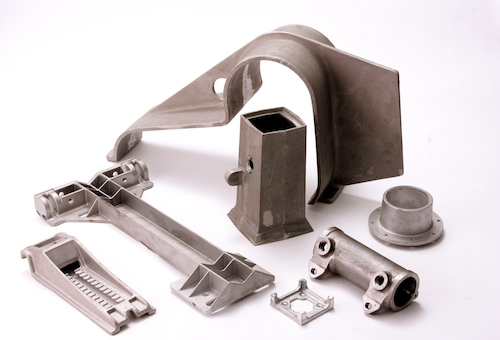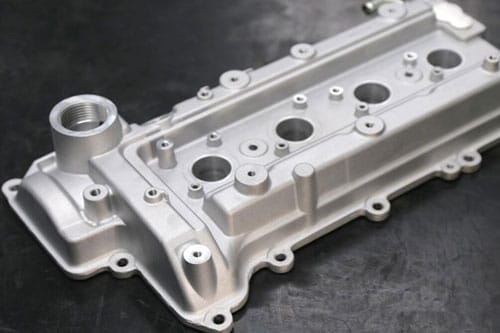All Regarding Aluminum Castings: Understanding Their Duty and Importance in Manufacturing
Aluminum spreadings are important to contemporary manufacturing, using a mix of lightweight homes and resilience. They help with complex styles while lessening setting up costs. Industries such as auto and aerospace regularly make use of these elements for enhanced performance. The production of aluminum castings is not without its difficulties. Comprehending the nuances of this process exposes both the benefits and prospective challenges. Checking out these elements will supply much deeper understandings right into their growing importance.
Introduction of Aluminum Spreading Processes
Aluminum casting procedures play a vital duty in production, providing versatility and performance. These processes entail pouring liquified light weight aluminum into molds to produce accurate shapes and elements. Different strategies are utilized, consisting of sand casting, pass away spreading, and financial investment casting, each differentiated by its technique of mold and mildew creation and the desired application.
Sand spreading uses a combination of sand and binder to create molds, permitting for complex geometries. Die casting, on the various other hand, involves compeling molten light weight aluminum right into metal molds, leading to high precision and smooth finishes. Investment spreading, typically made use of for intricate designs, includes producing a wax pattern covered with a ceramic covering, which is then filled up with molten aluminum.
These casting techniques accommodate varied commercial needs, making light weight aluminum a preferred material for parts in fields such as vehicle, aerospace, and consumer items. The choice of casting strategy significantly influences the end product's quality and performance.
Advantages of Using Aluminum Castings
The advantages of using light weight aluminum castings in manufacturing are significant and numerous. To start with, aluminum's light-weight nature adds to reduced overall product weight, improving energy performance in applications such as vehicle and aerospace markets. Furthermore, aluminum spreadings exhibit superb corrosion resistance, ensuring longevity and durability in extreme atmospheres. The material's electrical and thermal conductivity likewise makes it suitable for different applications, including electronics and warmth exchangers.
Additionally, aluminum castings can be created with elaborate layouts, allowing for much more complex forms that fulfill certain practical needs. This convenience adds to decreased assembly expenses and boosted layout adaptability. The casting process itself is effective, enabling for high-volume manufacturing with consistent top quality. Lastly, light weight aluminum is recyclable, making it an eco-friendly option in production. Collectively, these advantages highlight why aluminum spreadings are significantly favored throughout varied sectors, using both efficiency advantages and financial effectiveness.
Common Applications of Aluminum Castings
While various materials are utilized in production, aluminum spreadings stick out due to their broad variety of applications across multiple markets. These spreadings are extensively made use of in the automobile industry for engine components, transmission housings, and architectural parts, contributing to lighter lorries and boosted gas performance. In the aerospace industry, aluminum spreadings are important for aircraft components, where weight decrease is essential for efficiency and safety.
Additionally, the electric sector uses light weight aluminum spreadings for real estates and architectural aspects in machinery, profiting from the product's excellent conductivity. In customer goods, light weight aluminum castings can be discovered in things such as appliances and showing off devices, giving sturdiness and a modern aesthetic. The building sector utilizes light weight aluminum spreadings in building elements, home window structures, and components, showcasing their convenience and stamina. Overall, light weight aluminum castings play an integral function in boosting item efficiency and efficiency throughout different markets.
Secret Manufacturing Techniques for Light Weight Aluminum Castings
The manufacturing of aluminum castings depends on numerous methods, with sand casting and pass away casting being among one of the most popular. Sand spreading includes producing mold and mildews from sand, permitting intricate layouts and large components. On the other hand, die casting uses high-pressure shot of liquified light weight aluminum into recyclable mold and mildews, supplying precision and effectiveness for automation.
Sand Casting Process
Sand casting stands as one of one of the most widely made use of methods for creating light weight aluminum spreadings, thanks to its flexibility and cost-effectiveness. This procedure entails creating a mold from a blend of sand and a bonding agent, generally clay. As soon as the mold is ready, liquified light weight aluminum is put into it, permitting the steel to fill up the tooth cavity. After cooling, the mold is escaped to disclose the casting. Sand spreading fits complicated geometries and large parts, making it ideal for various applications. Furthermore, it enables simple adjustments, allowing manufacturers to change layouts promptly. The surface area coating may need extra machining for specific applications, making certain the final product meets high quality criteria.
Pass Away Casting Approaches
Die casting stands for a highly efficient technique for creating light weight aluminum castings, defined by its ability to provide high accuracy and superb surface area coating. This he said strategy mainly involves compeling molten light weight aluminum into a mold and mildew under high stress, guaranteeing that fine information and complex forms are recorded precisely. There are 2 main die spreading techniques: hot chamber and chilly chamber. Warm chamber pass away casting is appropriate for alloys with low melting factors and enables for faster cycles, while cold chamber die casting is excellent for high-temperature alloys, requiring different melting systems. Both methods improve production rates and lower material waste, making pass away casting a favored selection in sectors such as auto and electronic devices, where toughness and dimensional accuracy are paramount.
Sustainability in Aluminum Casting Production
While the demand for aluminum castings continues to expand, producers are progressively focusing on sustainability in their manufacturing procedures. This shift is driven by the demand to reduce ecological impact and preserve natural resources. Lots of firms are adopting reusing initiatives, using scrap aluminum, which notably decreases energy consumption and greenhouse gas discharges contrasted to key light weight aluminum manufacturing. In addition, innovations in casting modern technologies are allowing much more reliable use materials, reducing waste throughout the production process.
Producers are additionally checking out environmentally friendly choices to conventional spreading approaches, such as 3D printing and advanced mold and mildew technologies, which assist enhance resource use. Aluminum Foundry. Furthermore, applying sustainable methods in supply chain monitoring assurances that resources are sourced properly. As a result, the light weight aluminum spreading sector is making strides towards a more lasting future, lining up with international Related Site environmental goals while fulfilling the raising need for high-performance light weight aluminum items
Obstacles and Considerations in Light Weight Aluminum Spreading
Light weight aluminum casting presents numerous difficulties that makers should browse to guarantee product honesty. Style complexity can make complex the spreading procedure, leading to potential defects and raised manufacturing time. In addition, maintaining strenuous high quality control criteria is important to satisfy the demands of accuracy and dependability in completed elements.

Design Complexity Issues
Creating elements for light weight aluminum spreading presents various complexities that engineers must navigate to attain perfect results. One substantial challenge is the demand for exact geometry; elaborate styles can result in problems in mold development and increased risk of flaws. Additionally, thermal residential or commercial properties of light weight aluminum demand cautious consideration of cooling rates, as uneven air conditioning can create warping. Wall surface density variants also position an obstacle, as they can affect circulation qualities and architectural honesty. Designers have to balance design aesthetic appeals with manufacturability, making certain that functions such as fillets and ribs are enhanced for stamina without complicating the casting process. Ultimately, factors to consider pertaining to draft angles are necessary to help with mold and mildew release, more making complex the style procedure. These variables jointly underscore Recommended Reading the complexities included in aluminum spreading style.
Top Quality Control Challenges
Achieving top notch aluminum spreadings involves maneuvering a variety of quality assurance obstacles that can substantially influence the end product. Variations in raw material composition can lead to inconsistencies in casting residential properties, making it important to guarantee material quality. Second, the spreading process itself is prone to problems, such as porosity and shrinkage, which can jeopardize structural stability. Additionally, temperature level control throughout melting and putting is vital; fluctuations can lead to uneven solidification, influencing dimensional accuracy. Furthermore, complete inspection methods, including non-destructive screening, should be employed to identify flaws early. Preserving rigid process documentation and adherence to market criteria is indispensable for traceability and quality guarantee, highlighting the elaborate equilibrium required to produce dependable light weight aluminum castings in production.
Future Fads in Aluminum Spreading Modern Technology
As manufacturers endeavor to improve performance and sustainability, technologies in aluminum spreading innovation are emerging to fulfill these demands. One considerable fad is the integration of automation and expert system, which simplify manufacturing procedures and enhance accuracy in casting operations. These innovations minimize human error and enhance source use, eventually bring about cost reductions.
Furthermore, the fostering of sophisticated products and alloys is reshaping the landscape. New formulas boost performance features, such as corrosion resistance and lightweight residential or commercial properties, making aluminum castings a lot more functional across different sectors.
In addition, sustainable methods are acquiring grip, with an emphasis on recycling and reducing waste. Techniques such as 3D printing are likewise being discovered to create complicated geometries that were formerly unattainable
Often Asked Concerns

Exactly How Do Light Weight Aluminum Castings Contrast to Various Other Materials?
Light weight aluminum castings provide benefits such as light-weight, corrosion resistance, and exceptional thermal conductivity compared to other products. They are typically liked for applications requiring toughness and effectiveness, specifically in aerospace and auto markets.
What Is the Lifespan of Aluminum Castings?
The life expectancy of light weight aluminum spreadings usually varies from 10 to half a century, relying on environmental problems, use, and maintenance. Their rust resistance and longevity contribute noticeably to their lasting performance in various applications.
Can Aluminum Castings Be Recycled?
Yes, aluminum castings can be recycled. The reusing procedure is effective, enabling for the recuperation of light weight aluminum without significant loss of high quality, making it a lasting selection in production and reducing environmental effect.
What Safety Actions Are Needed Throughout Light Weight Aluminum Spreading?
Throughout light weight aluminum casting, essential safety steps consist of using proper individual safety equipment, guaranteeing appropriate ventilation, preserving tools, utilizing fire-resistant products, and executing secure handling protocols for molten metal to prevent injuries and crashes.
Exactly How Do Temperature Changes Impact Light Weight Aluminum Castings?
Temperature level changes substantially influence light weight aluminum castings by affecting fluidity, solidification rates, and mechanical properties. Quick cooling can bring about raised brittleness, while gradual air conditioning promotes much better structural integrity and decreases the risk of problems.
Die spreading, on the other hand, entails forcing liquified aluminum into metal mold and mildews, resulting in high precision and smooth finishes. The manufacturing of aluminum castings relies on numerous strategies, with sand spreading and die spreading being amongst the most popular. Sand casting stands as one of the most widely made use of techniques for generating aluminum castings, thanks to its adaptability and cost-effectiveness. Die casting stands for a highly effective method for producing aluminum castings, identified by its capability to provide high accuracy and excellent surface coating. While the demand for aluminum spreadings continues to expand, suppliers are progressively prioritizing sustainability in their production procedures.